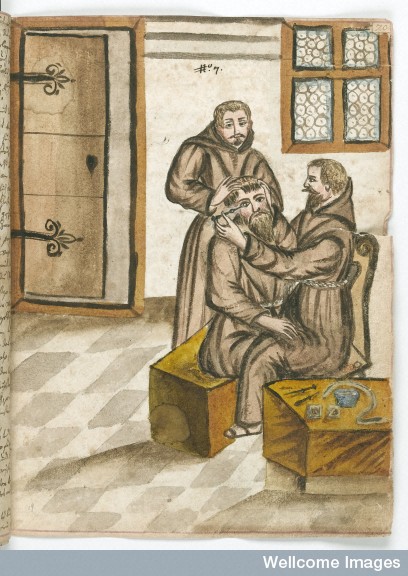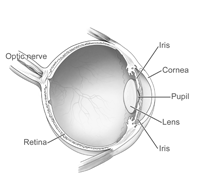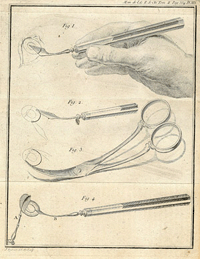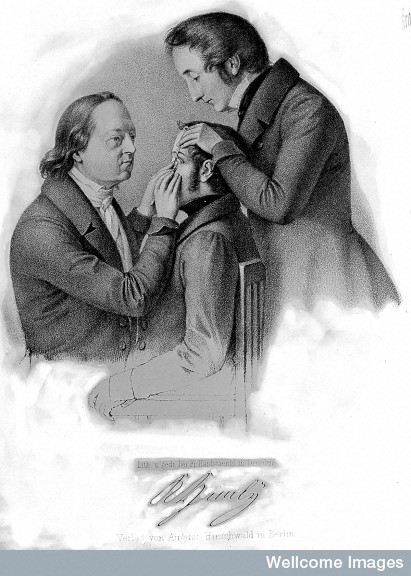Abstract
The date and the nature of Patrick Brontë’s cataract surgery illustrate both progress and its lack in the science and practice of British ophthalmology. The “newest” form of such surgery, cataract extraction (developed more than a century before) and the oldest, couching (more than 2,000 years old), were both being performed by British surgeons around the mid-point of the Victorian era. Ophthalmology was one of the first specializations to become a respectable profession in British medicine, but its greatest successes—such as the cure of blindness caused by cataracts—were achieved by those willing to adopt innovative surgical techniques and new medical treatments largely developed elsewhere.
In a marginal note made in his copy of Thomas John Graham’s Modern Domestic Medicine (1826), the nearly seventy-year-old Rev. Patrick Brontë (1777-1861) described his recent experience of cataract surgery:
When Brontë decided to have surgery done to cure his blindness, more than one surgical method was in use in Britain. A surgeon might have elected only to “couch” the cataract: that is, to insert a lancet or needle into the lens clouded by the “cataract”–an opacification of the lens that blocks the entry of light through it and thus causes loss of vision–and then simply push the lens down or backwards, into the vitreous-filled cavity of the eye. This procedure allowed light to enter the eye through the pupil and reach the retina, so that the patient could see. The term “couch” comes from the French “coucher,” to lie down or recline, as the lens itself is pushed down or back. This procedure had been known in the Western world for over 2,000 years, and in the Eastern world, such as“Belladonna—a virulent poison—was first applied, twice, in order to expand the pupil—this occasioned very acute pains for only about five seconds—The feeling, under the operation—which lasted fifteen minutes, was of a burning nature—but not intolerable—as I have read is generally the case, in surgical operation. My lens was extracted so that cataract can . . . never return in that eye.” (Barker 507)
By the time of Brontë’s operation, however, more progressive and better surgeons were extracting the lens entirely. This was done by cutting a corneal flap on the eye, lifting it, and extracting the lens from its capsule through an incision beneath the flap. (See Fig. 2.) This procedure required more specialized knowledge of eye anatomy, greater surgical skill, and a variety of specialized instruments. (See Fig. 3.)
But it meant, as Brontë was told, that the cataract could never return. Because surgeons did not yet know how to use stitches to hold the incision in the eye together, the patient had to lie quietly in a darkened room for weeks after the operation. Charlotte Brontë (1816-55), who had accompanied her father toPatrick’s cataract extraction was performed near the mid-point of the century, and it was also near the mid-point of the emergence and professionalization of the specialist field of ophthalmology in Britain. At the beginning of the century, specialization in diseases of the eye was regarded with contempt as the province of “quacks, mountebanks, and itinerant practitioners,” as William Laurence (1783-1867) wrote in A Treatise on the Diseases of the Eye (1833). All specialization was considered an inferior form of medical/surgical practice in Britain at this time, but restriction of practice to diseases of the eye (and ear) carried especially low prestige.[1] A conjunction of medical, political and cultural factors, however, reversed this situation for specialization in eye diseases and resulted in ophthalmology becoming one of the fastest growing specialties in nineteenth-century Britain.[2] Indeed, the treatment and prevention of blindness became one of the few success stories in Victorian medicine. In 1851 the proportion of blind persons to the general population was 1,110 per million, but by 1901 it had dropped to 830 per million (Oliphant 51).
But this success was largely due to the slow and often conflictual adoption in Britain of new medical and surgical knowledge produced on the Continent, rather than to advances made by British surgeons. Throughout the nineteenth century, most important advances in the treatment and prevention of blindness were made by French, German and Austrian physicians. Significant progress by British practitioners in this field was usually indicative of their willingness to learn from those nations whose soldiers opposed their own on the battlefield. The technique for cataract extraction, for example, had been developed by a French surgeon, Jacques Daviel (1696-1792), who first reported on his new procedure to the French Academy of Surgery on November 15, 1752 (Blodi 168). The report was published in 1753, so surgeons who had access to medical journals and could read French were able to learn about it. Yet by the mid-nineteenth century, only some British surgeons were practicing this superior technique for permanently curing blindness caused by cataracts. In the late eighteenth century, one of Britain’s most famous surgeons, Percivall Pott (1714-1788), after whom “Pott’s disease” (tuberculosis of the spine) was named, declared that cataract extraction was only a “kind of fashion” (qtd. in Blodi 169). The Austrian surgeon Georg Joseph Beer (1763-1821) commented candidly: “Some of the English ophthalmologists rejected the extraction method in order to please Mr Pott, others in order to stand out among the crowd. A third group did it out of national pride and out of hate of all French. And a fourth group did it because they had bad results due to prejudice or clumsiness” (qtd. in Blodi 169). All of these factors continued to function in British ophthalmological politics and practice for at least a century after Daviel’s report on his revolutionary procedure.
Despite the general opprobrium attached to specialization, an increasing number of British surgeons began to specialize in the eye and its diseases from the first years of the nineteenth century, even daring to call themselves “oculists.” (The terms “ophthalmology” and “ophthalmologist” were not in regular use until after the mid-point of the century [Davidson 314 n5]). One of the most important factors leading to the formation and professionalization of ophthalmology was the emergence of a “new” disease, the epidemic of “Egyptian ophthalmia” that disastrously affected both British and French soldiers in the Napoleonic campaign in ![]() Egypt (1798-1801? -1803?).[3] Appearing as a purulent and extremely contagious eye infection that could result in blindness of one or both eyes, the “Egyptian ophthalmia” wreaked havoc with both British and French troops, leading to hospitalization of whole regiments. In Britain, a tremendous demand for more hospitals was created, and for the first time a hospital devoted solely to treatment of the eye, the Royal Infirmary for the Diseases of the Eye in
Egypt (1798-1801? -1803?).[3] Appearing as a purulent and extremely contagious eye infection that could result in blindness of one or both eyes, the “Egyptian ophthalmia” wreaked havoc with both British and French troops, leading to hospitalization of whole regiments. In Britain, a tremendous demand for more hospitals was created, and for the first time a hospital devoted solely to treatment of the eye, the Royal Infirmary for the Diseases of the Eye in ![]() Cork Street, was opened in 1804 (Black 57). The following year John Cunningham Saunders (1773-1810) founded the
Cork Street, was opened in 1804 (Black 57). The following year John Cunningham Saunders (1773-1810) founded the ![]() London Dispensary for Curing Diseases of the Eye and Ear, which later expanded and became Moorfields Eye Hospital, still a major hospital in London today (Black 57). But it was not just the nature of the epidemic itself (in fact this was not a new disease, as there had been earlier epidemics among civilian populations), but the political and nationalist energies stirred by it that led to new interest in diseases of the eye and a new respect for practitioners who began to specialize in this field. King George the III (1738-1820) backed the first eye hospital, and between 1815 and 1835, many new ophthalmic hospitals were founded not only in London but in Dublin and Edinburgh (Davidson 323).
London Dispensary for Curing Diseases of the Eye and Ear, which later expanded and became Moorfields Eye Hospital, still a major hospital in London today (Black 57). But it was not just the nature of the epidemic itself (in fact this was not a new disease, as there had been earlier epidemics among civilian populations), but the political and nationalist energies stirred by it that led to new interest in diseases of the eye and a new respect for practitioners who began to specialize in this field. King George the III (1738-1820) backed the first eye hospital, and between 1815 and 1835, many new ophthalmic hospitals were founded not only in London but in Dublin and Edinburgh (Davidson 323).
As Luke Davidson demonstrates in his now classic essay, “‘Identities Ascertained’: British Ophthalmology in the First Half of the Nineteenth Century,” the “Egyptian ophthalmia” carried profound economic and moral implications. In contrast with such aging civilians as Patrick Brontë, every blind soldier or sailor was a potential candidate for government support for the rest of his life. This imperative financial fact fueled intense attention to the possible causes as well as treatment of eye diseases and prevention of blindness. The “Egyptian ophthalmia” had early on been suspected of having some connection with the gonorrhea that was widespread among the troops, and that was also linked with ophthalmia neonatorum, or newborn blindness caused by infection of the infant during its delivery through the birth canal. (Both newborn and adult infections of the eye were later recognized as also caused by trachoma, a disease that can be spread either through sexual contact or contact with infected hands, towels, etc. [Edwards 154-57]). But even the anatomical features of diseases of the eye had not been much studied before the epidemic. It is no accident that the Scottish surgeon James Wardrop (1782-1869) produced what is regarded as the founding study of ophthalmic pathology, Essays on the Morbid Anatomy of the Human Eye, in 1808, or that Lawrence’s first book on the eye, produced while he was director of the new Moorfields Eye Hospital in London, was A Treatise on the Venereal Diseases of the Eye (1830).[4] It was obviously crucial to keep the imperial armies as healthy as possible, and in particular, to protect their eyesight. The economic implications of the “Egyptian Ophthalmia” epidemic also shaped the philosophy of new “schools” for the blind, whose primary purpose was seen to be that of teaching the blind a trade by which they could support themselves without the aid of eyesight. Meanwhile, the moral implications of what came to be recognized as a venereal epidemic presented a conundrum: should blindness, traditionally romanticized and identified with poetic insight, instead be seen as morally just punishment for sexual sin?
As more British surgeons began to specialize in diseases of the eye (ophthalmology remained a largely surgical specialty until after the mid-nineteenth century), it became desirable to promote the primary importance of the eye, and thereby the professional prestige of those who devoted their practice to its care and treatment. Blindness, in turn, was represented as the most pitiable of all afflictions. In his first lecture on “the anatomy, physiology, and diseases of the eye,” printed in the October 1825 issue of the Lancet, William Lawrence quoted from Milton’s lines on blindness, “Thus with the year/ Seasons return; but not to me returns/ Day, or the sweet approach of eve or morn . . .” (Paradise Lost 3.40-42) to give poetic weight to his claim that “blindness is one of the greatest calamities that can befal [sic] human nature short of death; and many think that the termination of existence would be preferable to its continuance in the solitary, dependent, and imperfect state to which human life is reduced by the privation of this precious sense” (Lawrence 145). Quoting “our great poet” of course also demonstrated Lawrence’s gentlemanly education, and incidentally testified to his respect for the English literary tradition, even if he was known to place French medicine above that of his own country. Lawrence had not only praised French science but drawn unfavorable comparisons between the research facilities supported by the post-Revolutionary government and the severely limited support for research in Britain (Jacyna).
Other surgeons who specialized in treatment of the eye also eulogized the eye and in the process elevated the treatment of blindness to a high moral enterprise. John Stevenson, of the London Eye Infirmary, wrote that “the organ of vision is unquestionably the most valuable, the most indispensable, and the most ornamental of our senses. In proportion therefore to the acknowledged importance of the Eye, its loss or imperfection, has ever been justly dreaded and deplored as most grievous misfortune” (qtd. in Davidson 326-7). Although reviewers often attacked such sentiment, the early textbooks on diseases and treatment of the eye undoubtedly promoted both the authority of specialists and literary discourse that represented vision as the primary sense. (Hearing, or the loss of hearing, by contrast, though first taken up as literary subject during the Victorian era, was still represented as an eccentric topic, as opposed to the universal interest assumed for vision and blindness [Carpenter 121-127]).[5] Davidson notes that the surgical praise of the eye drew on natural theology, in which the eye was proof of the “argument from design,” as in the Scottish physician George Cheyne’s (1671-1743) “ecstatic” statement: “He certainly deserves not to enjoy the Blessings of his Eye sight, whose Mind is so deprav’d, as not to acknowledge the Bounty and Wisdom of the Author of his Nature, in the ravishing and astonishing Structure of this noble Organ” (qtd. in Davidson 328). Sir Charles Bell (1774-1842), an eminent Scottish surgeon and anatomist, believed that the eye “offered the most obvious arguments in favour of the goodness and existence of God” (qtd. in Davidson 331). Davidson comments that ophthalmological writers used what could best be described as a “language of love” for that object of their practice, the eye (Davidson 328).
In 1850 a German, Hermann von Helmholtz (1821-94), invented the instrument which was to transform the practice of ophthalmology—the ophthalmoscope. Helmholtz, though trained as a physician in the Royal Friedrich-Wilhelm Institute for Medicine and Surgery in ![]() Berlin, was primarily interested in physics, especially the science of optics. He did not regard himself as the inventor of the ophthalmoscope, saying to his father that the idea of the instrument was so obvious, it did not require any more knowledge than what he had learned about optics in high school. He spoke of it instead as a “discovery” or an “unfolding” (Albert, “Ophthalmoscope” 186-88). But Albrecht von Graefe (1828-70), later to become well-known as the inventor of a new operation for the treatment of acute glaucoma, immediately recognized the revolutionary significance of this new instrument:
Berlin, was primarily interested in physics, especially the science of optics. He did not regard himself as the inventor of the ophthalmoscope, saying to his father that the idea of the instrument was so obvious, it did not require any more knowledge than what he had learned about optics in high school. He spoke of it instead as a “discovery” or an “unfolding” (Albert, “Ophthalmoscope” 186-88). But Albrecht von Graefe (1828-70), later to become well-known as the inventor of a new operation for the treatment of acute glaucoma, immediately recognized the revolutionary significance of this new instrument:
When he for the first time saw the background of the eye, with its nerve entrance and its blood-vessels, his cheeks reddened, and he called out excitedly, “Helmholtz has unfolded to us a new world!” (qtd. in Albert, “Ophthalmoscope” 189).
The new instrument allowed the examiner to see inside the living eye for the first time in history. All previous studies of the anatomy of the eye, such as Wardrop’s Morbid Anatomy of the Human Eye, had been based on observations of the nonliving eye.
The new instrument was demonstrated at the First International Ophthalmological Exhibition, which was held in London in 1851 and attended by ophthalmologists from all over Europe. The next two decades have been called the “Golden Age of Ophthalmology,” as exciting discoveries made with the new instrument were described in medical journals (Albert, “Ophthalmoscope” 191). With the ophthalmoscope, British physicians (for after the Medical Act of 1858, practitioners were increasingly qualified in both medicine and surgery) were able to detect not only diseases of the eye, but indications of illness elsewhere in the body, such as hypertension (not otherwise able to be diagnosed until the invention of the syphgmomanometer in 1896), diabetes, heart disease and brain tumors. In time, they were also able to measure precisely the refractive errors of the eye with the ophthalmoscope and to prescribe spectacles with lenses ground to correct those specific errors, rather than prescribing lenses largely on the basis of the age of the patient. It was the ophthalmoscope that allowed von Graefe to invent the new surgical procedure known as iridectomy, or removal of a part of the iris in order to enhance drainage of excess fluid from the eye and thus lower intraocular eye pressure in the treatment of acute glaucoma. But British ophthalmologists did not necessarily rush to learn how to use the ophthalmoscope. In the early years after its invention, some surgeons feared that reflecting bright light directly into the eye might damage the retina (Albert, “Ophthalmoscope,” 188). Cliffords Albutt (1836-1925) regretfully noted in the introductory chapter of his textbook, On the Use of the Ophthalmoscope in diseases of the nervous system and of the kidneys: also in certain other general disorders (1871) that “the number of physicians who are working with the ophthalmoscope in England may, I believe, be counted on the fingers of one hand” (qtd. in Albert, “Ophthalmoscope,” 192).
And although the German obstetrician Karl Siegmund Franz Credé (1810-1892) demonstrated in 1881 that a single drop of a 2% solution of silver nitrate placed into the eyes of a newborn could prevent nearly all cases of ophthalmia neonatorum, the British ophthalmic surgeon Simeon Snell reported in 1891 that he believed almost 40% of the children in the ![]() Sheffield Institution for the Blind had been rendered blind by this condition. For the last few years, he stated, every parent bringing an infant suffering from ophthalmia neonatorum to the
Sheffield Institution for the Blind had been rendered blind by this condition. For the last few years, he stated, every parent bringing an infant suffering from ophthalmia neonatorum to the ![]() Sheffield General Infirmary had been presented with a card that read:
Sheffield General Infirmary had been presented with a card that read:
Important: If a baby’s eyes run with matter and look red a few days after birth, take it at once to a doctor. Delay is dangerous, and one or both eyes may be destroyed it not treated immediately. (Snell 926)
The words in italics were printed in red to emphasize the gravity of the disease. Nevertheless, obstetricians and midwives were still not uniformly trained in Credé’s method, or even in careful cleansing of the newborn’s eyes with plain water, which had been shown to be a sufficient preventive in some cases. Hence, at the end of the Victorian era, the same veneral diseases that had—by their causation of the horrific “Egyptian ophthalmia,”—blinded huge numbers of soldier and sailors, were still causing blindness in untold numbers of children. The now established profession of ophthalmology in Britain still lagged behind that profession on the Continent. Nevertheless, as Patrick Brontë’s case shows, many of those who would have been blind could now see, thanks to the incorporation of Continental ophthalmological knowledge into British ophthalmology by the more cosmopolitan members of that new Victorian specialty.
HOW TO CITE THIS BRANCH ENTRY (MLA format)
published October 2012
Carpenter, Mary Wilson. “A Cultural History of Ophthalmology in Nineteenth-Century Britain.” BRANCH: Britain, Representation and Nineteenth-Century History. Ed. Dino Franco Felluga. Extension of Romanticism and Victorianism on the Net. Web. [Here, add your last date of access to BRANCH].
WORKS CITED
Albert, Daniel M. “The Development of Ophthalmic Pathology.” The History of Ophthalmology. Ed. Daniel Albert and Diane D. Edwards. Cambridge, MA: Blackwell Science, 1996. 65-106. Print.
Albert, Daniel M. “The Ophthalmoscope and Retinovitreous Surgery.” The History of Ophthalmology. Ed. Daniel Albert and Diane D. Edwards. Cambridge, MA: Blackwell Science, 1996. 177-202. Print.
Barker, Juliet. The Brontës. NY: St. Martin’s Griffin, 1984. Print.
Black, Nick. Walking London’s Medical History. London: Royal Society of Medicine Ltd, 2006. Print.
Blodi, Frederick C. “Cataract Surgery.” The History of Ophthalmology. Ed. Daniel Albert and Diane D. Edwards. Cambridge, MA: Blackwell Science, 1996. 165-75. Print.
Carpenter, Mary Wilson. Health, Medicine, and Society in Victorian England. Oxford: Praeger, 2010. Print.
Davidson, Luke, “‘Identities Ascertained’: British Ophthalmology in the First Half of the Nineteenth Century.” Social History of Medicine 9.3 (1996): 313-333. Web.
Edwards, Diane D. “Microbiology of the Eye and Ophthalmia.” The History of Ophthalmology. Ed. Daniel Albert and Diane D. Edwards. Cambridge, MA: Blackwell Science, 1996. 147-163. Print.
Favret, Mary A. “The Napoleonic Wars.” BRANCH: Britain, Representation and Nineteenth-Century History. Ed. Dino Franco Felluga. Extension of Romanticism and Victorianism on the Net. Web. 22 October 2012.
Holmes, Martha Stoddard. Fictions of Affliction: Physical Disability in Victorian Culture. Ann Arbor: Michigan UP, 2009. Print.
Jacyna, L. S. “Lawrence, Sir William, first baronet (1783-1867).” Oxford Dictionary of National Biography. Oxford UP, 2004. Web. 23 Feb 2009.
Lawrence, William. “Lectures on the Anatomy, Physiology, and Diseases of the Eye: Lecture 1.” The Lancet 5:112 (22 Oct 1825): 145-151. Web. 28 Apr 2012.
Oliphant, John. The Early Education of the Blind in Britain c.1790-1900: Institutional Experience in England and Scotland. Queenston, ON: Edwin Mellen Press, 2007. Print.
Rosen, George. The Specialization of Medicine with Particular Reference to Ophthalmology. New York: Arno Press & The New York Times, 1972 reprint edition (orig. pub. 1944). Print.
Snell, Simeon. “The Prevention of Ophthalmia in the New-Born.” The Lancet 137: 3530 (April 25, 1891) 926-27. Web. 3 May 2012.
ENDNOTES
[1] As late as the 1860s, the ![]() British Medical Association and the British Medical Journal carried out a campaign against all forms of specialization in medicine and surgery (Davidson 319).
British Medical Association and the British Medical Journal carried out a campaign against all forms of specialization in medicine and surgery (Davidson 319).
[2] Although it is not possible to state precisely when specialization in diseases of the eye became respectable in Britain, both the rapid expansion of eye hospitals and the increase in production of textbooks and other scientific works on pathologies of the eye before 1840 suggest that this change had taken place by the mid-point of the nineteenth century (Davidson 323-24). George Rosen’s foundational study of specialization posits that ophthalmology was the first “modern” type of specialization to appear in Western medicine, i.e., the first to be founded on scientific principles rather than itinerant practice (54).
[3] See Mary Favret, “The Napoleonic Wars,” for discussion of the difficulty of dating any specific campaign in these wars. Historians of ophthalmology variously date the end of the Egyptian campaign as 1801 or 1803.
[4] Daniel Albert, however, notes that Wardrop’s book drew on earlier work on ophthalmic pathology by Antonio Scarpa (1752-1832), Antoine Maître-Jan (1650-1725), and other continental sources (“Ophthalmic Pathology,” 72-74).
[5] Martha Stoddard Holmes writes extensively about the few representations of deafness in Victorian fiction, while the shortness of her list of deaf characters compared with the length of the list of blind characters in her Appendix drives home the priority of the visual over the hearing sense in Victorian literature and culture.




